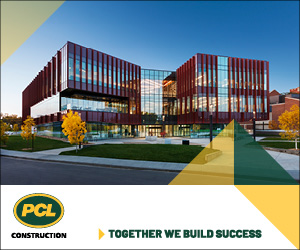By Connie Vitello
By all accounts the Gordie Howe International Bridge project is a once-in-a-generation infrastructure project with a price tag to match: $5.7 billion. When constructed, this bridge will have the longest main span of any cable-stayed bridge in North America and the ports of entry among the largest along the Canada-U.S. border.
Not only will the project deliver much-needed transportation improvements for international travellers, but it will also provide jobs and opportunities for growth to the Windsor-Detroit region.
Thanks to a public-private partnership (P3) that incorporates a long-term performance-based approach to procuring public infrastructure, the private sector partners are assuming a major share of the risks in terms of financing and construction. Inherently, the P3 model ensures effective performance, from design and planning to long-term maintenance.
To manage a project of this magnitude requires the kind of leadership qualities exhibited by the bridge’s namesake, Canadian hockey great Gordie Howe, who led the Detroit Red Wings to four Stanley Cup victories.
Bryce Phillips joined Windsor-Detroit Bridge Authority (WDBA), the Crown corporation that managed the procurement process and is responsible for the delivery of the project, as CEO, following an appointment by the federal government in 2018. A native of Windsor, Phillips brings more than 35 years of experience as an executive in the infrastructure and energy sectors.
ReNew Canada recently engaged Phillips to discuss the winning strategy that’s going into getting this massive project successfully completed on time and on budget.

How did your previous work experience prepare you to take on this complex infrastructure project? Share some of the lessons learned that provided you with the wisdom and industry know-how to guide your project team.
As a Mechanical Engineer, graduating from the University of Windsor, I have had the privilege to hold positions throughout my career where I have led subject matter experts through challenging and complex projects. I have derived my leadership style from these experiences, which have also well positioned me to manage WDBA’s relationship with our private-sector partner, Bridging North America, as well as that of our other project partners.
Over my career, I have seen firsthand that people really are your greatest asset. Your project’s success depends to the people on your team. I have learned so much by asking the people on my team for their thoughts and ideas, by empowering them to be part of the decision-making process, and by encouraging innovation.
Also, I recognize that there will be disagreements along the way, but it is critical to never lose sight of the fact that you are all working toward achieving a common goal. There are always solutions.
The official start of construction was October 5, 2018. What have been the major milestones achieved so far, and what are some of the key construction milestones to come in 2022?
There was a significant amount of preparatory work that was undertaken both in Canada and the U.S. that allowed Bridging North America (BNA) to take over the sites and get to work after Financial Close was achieved on September 28, 2018. Since the start of construction, BNA has undertaken detailed design and construction simultaneously on the four project components.
In 2019, there was completion of the perimeter access road around the Canadian Port of Entry (POE), wind tunnel testing, placement of fill and installation of wick drains to accelerate soil consolidation at the ports of entry and demolition of three road bridges to be reconstructed for the Michigan Interchange.
2020 included the selection of design for pedestrian bridges as part of Michigan Interchange activities, completion of property acquisition in the U.S. (led by the State of Michigan), completion of tower footings, installation of art pieces on the tower cranes completed by local indigenous and Southwest Detroit artists.
In 2021 work began on the lower pylons of the bridge towers, and the project achieved the prestigious Envision platinum award for sustainable infrastructure. Construction of many buildings at the Canadian POE began, BNA completed 1,000 days of construction and three million hours of work without a lost-time injury.
Over 2022, crews will continue to advance phase two activities on the Michigan Interchange, complete the upper pylon of the tower legs and begin work on the side and back spans of the bridge and advance construction on the buildings at each of the ports of entry.
A major international project such as this, with multiple stakeholders and a variety of legal variances, would be challenging to navigate at the best of times. How did the pandemic impact construction timelines and factors such as stakeholder engagement?
The COVID-19 pandemic presented significant challenges to our long-standing approach to engagement and communications. When the COVID-19 crisis hit North America, the communications world we knew and practiced in was suddenly no more. On March 20, 2020, the Canada-U.S. land border was closed to non-essential travel. As WDBA is based in Ontario, this meant we were unable to meet with local Michigan residents in person. The closure of non-essential businesses in Ontario and Michigan meant we had to close our head office and two community offices, and pivot to working from home. In this unprecedented environment, we had to completely rethink our approach to stakeholder engagement and communications. We changed to a virtual environment and identified new ways to keep communities engaged with the project.
We developed plans to shift from in-person quarterly community meetings to a virtual environment and promoted alternative ways to contact WDBA, considering the closure of our community offices. Going online enabled us to deliver on our engagement commitments, and even allowed us to be exposed to a wider audience.
It also forced businesses to adjust in the way they operate to ensure that government directives were followed. Measures were put in place to ensure the health and safety of our workers, contractors, and the public. With these measures in place, construction on the project has been able to continue throughout the pandemic. As with any design-build project, adjustments to schedule may occur as design progresses. We are still understanding the possible impact that the pandemic may have on the project schedule. Windsor-Detroit Bridge Authority and Bridging North America have been taking steps to help mitigate significant disruption to project schedule.

An independent value analysis demonstrated that the P3 model for this project results in a savings of approximately $562.8 million. That is 10.7 per cent as compared to delivery of the project using traditional procurement methods. Tell us about the financial management process.
The contract with Bridging North America is not just fixed price. It is also outcome-based. This means that WDBA has set the requirements and outcomes for the project and has agreed that Bridging North America will be paid the contract amount for delivering those requirements. As a fixed cost contract, BNA assumes risk related to material cost increases or other cost fluctuations. Our contract with BNA is for 36 years and covers the six-year design and construction phase and a 30-year operations, maintenance, and rehabilitation phase.
Recently, the Government of Canada appointed Tim Murphy as Chair of WDBA’s Board of Directors. I’m pleased to have Canada’s leading expert in public-private partnerships working with us on the Gordie Howe International Bridge ensuring sound governance approaches are maintained ensuring ongoing value for money for Canadian taxpayers.
You mentioned that the project has four different main aspects: the cable-stayed bridge, the Canadian POE, the U.S. POE, and the Michigan Interchange. What are your favourite features about each of these aspects?
WDBA recognizes the permanent influence the Gordie Howe International Bridge will have on Windsor’s and Detroit’s skylines and its role as a new gateway symbol for Canada and the United States. Due to this, we are building elegance through aesthetics. Aesthetics, and its role in supporting functionality, have been considered for all aspects of the project.
For the bridge, I love that we were able to take the feedback of the community and integrate a multi-use path. Thus, contributing to active and healthy lifestyles for our host communities.
For the ports of entry, we are integrating technology to make our plazas state-of-the art. This will contribute to the efficient and timely movement of travellers through the facilities and toward their destinations and will provide our customers with a positive experience when making the Gordie Howe International Bridge their crossing of choice.
BNA has engaged more than 145 local businesses in Windsor-Essex and Detroit and more than 3,900 workers, about half of which are local. What is your team doing to make sure that the Community Benefits Plan that will be successful in carrying out initiatives that integrate positive outcomes for the local workforce and communities?
The development of the Community Benefits Plan was very community-driven, reflecting three years of engagement with Sandwich/Windsor and Delray/Detroit residents, businesses, workforce and educational institutions, elected officials, and other stakeholders. The initiatives in the plan are based on and align with the priorities that we heard.
We know that we can’t fully understand each community, so we carefully selected initiative delivery partners that have proven track records and are well-known in the respective communities. We spent a lot of time meeting with workforce and training agencies and organizations to better understand the two local workforce environments. These partnerships along with BNA’s relationships with subcontractors and unions are helping to ensure that residents have opportunities on the project and local businesses and vendors can participate in project procurements. Our current track record for local hiring and procurement indicates this approach is achieving success.
[This article originally appeared in the July/August 2022 edition of ReNew Canada.]
Connie Vitello is the contributing editor of ReNew Canada.
Featured image: The bridge towers for the Gordie Howe International Bridge have been under construction since 2019. Each inverted Y-shaped bridge tower is made of cast-in-place reinforced concrete. (WDBA)
















